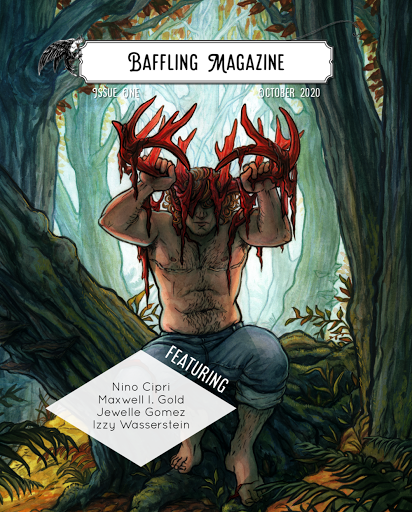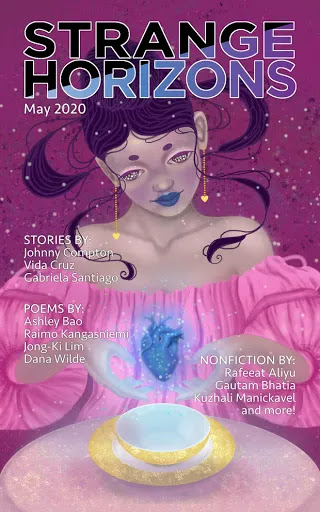Welcome to another edition of the New Books Spotlight, where each month or so we curate a selection of 6 new and forthcoming books we find notable, interesting, and intriguing. It gives us the opportunity to shine a brief spotlight on some stuff we're itching to get our hands on.
What are you looking forward to? Anything you want to argue with us about?
Harrow, Alix E. The Once and Future Witches [Orbit]
Publisher's Description
In the late 1800s, three sisters use witchcraft to change the course of history in Alix E. Harrow’s powerful novel of magic and the suffragette movement.
In 1893, there’s no such thing as witches. There used to be, in the wild, dark days before the burnings began, but now witching is nothing but tidy charms and nursery rhymes. If the modern woman wants any measure of power, she must find it at the ballot box.
But when the Eastwood sisters — James Juniper, Agnes Amaranth, and Beatrice Belladonna — join the suffragists of New Salem, they begin to pursue the forgotten words and ways that might turn the women’s movement into the witch’s movement. Stalked by shadows and sickness, hunted by forces who will not suffer a witch to vote — and perhaps not even to live — the sisters will need to delve into the oldest magics, draw new alliances, and heal the bond between them if they want to survive.
There’s no such thing as witches. But there will be.
An homage to the indomitable power and persistence of women, The Once and Future Witches reimagines stories of revolution, sapphic love, motherhood, and women’s suffrage–the lost ways are calling.
Why We Want It: When she wrote her breakout Hugo Award winning story "A Witch's Guide to Escape" Harrow dealt with both witches and portal fantasies. Her debut novel was all portal fantasy. This, her second, returns to witches. That's more anecdotal than anything, but interests me all the same. The real reason we're excited for The Once and Future Witches is because her previous novel, The Ten Thousand Doors of January was fucking excellent and we'll read anything she writes.
Kuang, R.F. The Burning God [Harper Voyager]
Publisher's Description
The exciting end to The Poppy War trilogy, R. F. Kuang’s acclaimed, award-winning epic fantasy that combines the history of twentieth-century China with a gripping world of gods and monsters, to devastating, enthralling effect.
After saving her nation of Nikan from foreign invaders and battling the evil Empress Su Daji in a brutal civil war, Fang Runin was betrayed by allies and left for dead.
Despite her losses, Rin hasn’t given up on those for whom she has sacrificed so much—the people of the southern provinces and especially Tikany, the village that is her home. Returning to her roots, Rin meets difficult challenges—and unexpected opportunities. While her new allies in the Southern Coalition leadership are sly and untrustworthy, Rin quickly realizes that the real power in Nikan lies with the millions of common people who thirst for vengeance and revere her as a goddess of salvation.
Backed by the masses and her Southern Army, Rin will use every weapon to defeat the Dragon Republic, the colonizing Hesperians, and all who threaten the sh
amanic arts and their practitioners. As her power and influence grows, though, will she be strong enough to resist the Phoenix’s intoxicating voice urging her to burn the world and everything in it?
Why We Want It: Let's face, we're gluttons for punishment and want our hearts stomped repeatedly. Lucky for us, we have R.F. Kuang to do exactly that because the first two Poppy War novels have been brutal and perfect bits of epic fantasy filled with betrayal and incredible personal sacrifice. There's no way this ends well for any of the characters and we wouldn't have it any other way.
Lethem, Jonathan. The Arrest [Harper Collins]
Publisher's Description
From the award-winning author of The Feral Detective and Motherless Brooklyn comes an utterly original post-collapse yarn about two siblings, the man that came between them, and a nuclear-powered super car.
The Arrest isn’t post-apocalypse. It isn’t a dystopia. It isn’t a utopia. It’s just what happens when much of what we take for granted—cars, guns, computers, and airplanes, for starters—quits working. . . .
Before the Arrest, Sandy Duplessis had a reasonably good life as a screenwriter in L.A. An old college friend and writing partner, the charismatic and malicious Peter Todbaum, had become one of the most powerful men in Hollywood. That didn’t hurt.
Now, post-Arrest, nothing is what it was. Sandy, who calls himself Journeyman, has landed in rural Maine. There he assists the butcher and delivers the food grown by his sister, Maddy, at her organic farm. But then Todbaum shows up in an extraordinary vehicle: a retrofitted tunnel-digger powered by a nuclear reactor. Todbaum has spent the Arrest smashing his way across a fragmented and phantasmagorical United States, trailing enmities all the way. Plopping back into the siblings’ life with his usual odious panache, his motives are entirely unclear. Can it be that Todbaum wants to produce one more extravaganza? Whatever he’s up to, it may fall to Journeyman to stop him.
Written with unrepentant joy and shot through with just the right amount of contemporary dread, The Arrest is speculative fiction at its absolute finest.
Why We Want It: The description from the publisher is a touch pretentious because, really, fuck you about this not being post apocalyptic or dystopic when technology stops working. That's exactly the tradition Lethem is working with and he damn well knows it, regardless of how the the publisher wants to market the novel. I haven't read Lethem in thirteen years since the incredibly disappointing You Don't Love Me Yet - but his earliest work was inventive and exciting even as he slid farther away from genre while still touching its edges. Regardless of what the publisher wants to call The Arrest, it's the sort of thing I like to read.
Muir, Tamsyn. Princess Floralinda and the Forty Flight Tower [Subterranean]
Publisher's Description
When the witch built the forty-flight tower, she made very sure to do the whole thing properly. Each flight contains a dreadful monster, ranging from a diamond-scaled dragon to a pack of slavering goblins. Should a prince battle his way to the top, he will be rewarded with a golden sword—and the lovely Princess Floralinda.Why We Want It: Taking a pause between Harrow the Ninth and the forthcoming Alecto the Ninth, Tamsyn Muir has a shorter and completely unrelated work. I'm not familiar with her short fiction before Muir exploded on the scene with Gideon the Ninth - but I'm excited to see what else Muir can do.
But no prince has managed to conquer the first flight yet, let alone get to the fortieth.
In fact, the supply of fresh princes seems to have quite dried up.
And winter is closing in on Floralinda…
Polk. C.L. The Midnight Bargain [Erewhon]
Publisher's Description
From the beloved World Fantasy Award-winning author of Witchmark comes The Midnight Bargain, a sweeping, romantic new fantasy set in a world reminiscent of Regency England, where women’s magic is taken from them when they marry. A sorceress must balance her desire to become the first great female magician against her duty to her family.Why We Want It: I'm not as familiar with C.L. Polk's fiction as I'd like to be, but Witchmark was superb, I have Stormsong on deck at home and I remember a long time ago she wrote several episodes of Shadow Unit. Shadow Unit, mind you, is one of my favorite things - which doesn't have a lot to do with the fiction she's written since Witchmark, but it built up an immense amount of goodwill on my part. The Midnight Bargain is also one of the first books published by Erewhon Books, the imprint founded by Liz Gorinsky (Hugo Award winning editor) - it's a pairing I don't want to miss.
Beatrice Clayborn is a sorceress who practices magic in secret, terrified of the day she will be locked into a marital collar that will cut off her powers to protect her unborn children. She dreams of becoming a full-fledged Magus and pursuing magic as her calling as men do, but her family has staked everything to equip her for Bargaining Season, when young men and women of means descend upon the city to negotiate the best marriages. The Clayborns are in severe debt, and only she can save them, by securing an advantageous match before their creditors come calling.
In a stroke of luck, Beatrice finds a grimoire that contains the key to becoming a Magus, but before she can purchase it, a rival sorceress swindles the book right out of her hands. Beatrice summons a spirit to help her get it back, but her new ally exacts a price: Beatrice’s first kiss . . . with her adversary’s brother, the handsome, compassionate, and fabulously wealthy Ianthe Lavan.
The more Beatrice is entangled with the Lavan siblings, the harder her decision becomes: If she casts the spell to become a Magus, she will devastate her family and lose the only man to ever see her for who she is; but if she marries—even for love—she will sacrifice her magic, her identity, and her dreams. But how can she choose just one, knowing she will forever
regret the path not taken?
Sanderson, Brandon. Rhythm of War [Tor]
Publisher's Description
The Stormlight Archive saga continues in Rhythm of War, the eagerly awaited sequel to Brandon Sanderson's #1 New York Times bestselling Oathbringer, from an epic fantasy writer at the top of his game.
After forming a coalition of human resistance against the enemy invasion, Dalinar Kholin and his Knights Radiant have spent a year fighting a protracted, brutal war. Neither side has gained an advantage, and the threat of a betrayal by Dalinar’s crafty ally Taravangian looms over every strategic move.
Now, as new technological discoveries by Navani Kholin’s scholars begin to change the face of the war, the enemy prepares a bold and dangerous operation. The arms race that follows will challenge the very core of the Radiant ideals, and potentially reveal the secrets of the ancient tower that was once the heart of their strength.Why We Want It: The Stormlight Archive is Brandon Sanderson's Magnum Opus, a ten volume series likely spanning decades of work even if we don't consider the other tangentially related Cosmere based novels that will bring the total upwards of thirty. This is doorstopper fantasy and Sanderson is the truest successor to Robert Jordan's Wheel of Time that we are likely to come across, for everything that entails.
At the same time that Kaladin Stormblessed must come to grips with his changing role within the Knights Radiant, his Windrunners face their own problem: As more and more deadly enemy Fused awaken to wage war, no more honorspren are willing to bond with humans to increase the number of Radiants. Adolin and Shallan must lead
the coalition’s envoy to the honorspren stronghold of Lasting Integrity and either convince the spren to join the cause against the evil god Odium, or personally face the storm of failure.
POSTED BY: Joe Sherry - Co-editor of Nerds of a Feather, 4x Hugo Award Finalist for Best Fanzine. Minnesotan. He / Him.






















